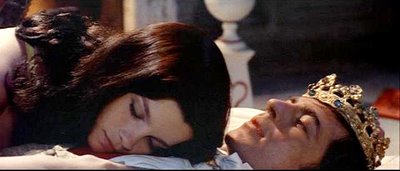
In the mid-'70s the midnight/cult movie was a new idea--and an exciting one, even if all-too-quickly the stultifying odor of marketing crept across that "phenomenon," turning it into another brand name, like "indie film." I was in college, and new theaters were cropping up in Philadelphia--the legendary Theater of the Living Arts/TLA and the Ritz--dedicated to non-Hollywood movies, domestic and foreign, old (TLA) and new (Ritz). I went online, and found that the Ritz has multiplied like Starbuck's, and still seems committed; but today there's a market for non-Hollywood movies--especially the ones Hollywood distributes--so it's no surprise that one can readily see Tsotsi and The Notorious Bettie Page, even in the multiplex. In 1974, though, you had to keep your fingers crossed, and jump when you had the chance.
It was in this atmosphere that I saw 1966's King of Hearts, in which Alan Bates' Private Plumpnick--"Pumpernickel" or simply "Nickel" to his clueless commander--discovers in the waning days of World War I a lasting truth of the cult movie world: that crazy is saner than sane, and that, as the film's famous final moment asserts, one needs to enter every world naked. Its satire is a bit heavy-handed--although that seems redundant--and its love of the topsy-turvy a bit precious, but I cannot feel superior to a film that borrows so convincingly from Fellini, both visually in its town-square surrealism and aurally in its circus-music soundtrack, and features Genevieve Bujold in full-'60s fawn-mode--and manages to evoke three or four moments of genuine feeling and truthful meaning. I watched it again yesterday, with my twelve-year-old son--who was mystified by its dogged lack of logical behavior--but he does not yet need to understand the liberties necessary in such a film to get Character A on a head-first collision with Character B--or maybe he simply knows better than the old man that when something doesn't make sense, it doesn't fully work, despite the cute distraction of capering whimsy. No matter: King of Hearts, while necessarily showing its age, holds up well, particularly in its sweet-natured affection for, well, affection--there are more than enough hugs and kisses to go around, as well as spontaneous sentimental tears and uplifted smiling faces--not to mention the occasional small, solemn moments in which the escaped mental patients--free to roam in the abandoned town (the Germans have planted a booby-trap that will explode the entire town by midnight, and all the regular citizens have evacuated)--reclaim their pasts--or invent new presents, becoming the town's nobility, prostitutes, generals and barbers--as well as circus performers and Bishops--and enjoy a new, one-day life of exuberance and left-handed wisdom.
 This we're-all-mad-here/wrong-is-right disposition is, of course, a cliche. But as I recall, King of Hearts was the first film I saw that put on this antic disposition, and so I forgive it now when it creaks. It remains a happy movie, eager to tweak war's nose and invite one to come out and play. This past weekend I also watched Chaplin in Modern Times (1936), and there too saw this impish urge: When Chaplin so gracefully, insanely, attempts to tighten with his wrenches every nut-shaped object in sight--and not just those comic shirt-buttons and nipples, but the nuts themselves of the machine as it grinds him beneath its wheels--I saw King of Heart's dervish-glee--and its smile-though-your-heart-is-breaking pathos. Always the softy, I find this a combination difficult to resist, and given Bates' quirks and befuddlement, and Bujold's open-eyed invitation, and the circus procession of the blissfully blind, I too wanted to go knocking at the asylum's gate.
This we're-all-mad-here/wrong-is-right disposition is, of course, a cliche. But as I recall, King of Hearts was the first film I saw that put on this antic disposition, and so I forgive it now when it creaks. It remains a happy movie, eager to tweak war's nose and invite one to come out and play. This past weekend I also watched Chaplin in Modern Times (1936), and there too saw this impish urge: When Chaplin so gracefully, insanely, attempts to tighten with his wrenches every nut-shaped object in sight--and not just those comic shirt-buttons and nipples, but the nuts themselves of the machine as it grinds him beneath its wheels--I saw King of Heart's dervish-glee--and its smile-though-your-heart-is-breaking pathos. Always the softy, I find this a combination difficult to resist, and given Bates' quirks and befuddlement, and Bujold's open-eyed invitation, and the circus procession of the blissfully blind, I too wanted to go knocking at the asylum's gate.
No comments:
Post a Comment